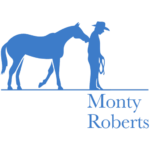LESSONS FROM THE ROUNDPEN PART I
By Monty Roberts
We live in restless times. In almost every area of life people can feel that things are changing and indeed must change. But no one knows where the necessary changes will lead or what they will mean for those concerned.
What, you may be asking yourself, can Monty Roberts, a Californian horse trainer, contribute in such times of general insecurity? To find the answer, the best place to start is with horses, because for me too, that is where everything began. I was born on a ranch in Salinas, California, and learned to ride as a small child. My father was a horse trainer but our relationship was strained, to say the least. I could never come to terms with the violent methods with which he would quite literally break the will of young horses until they obeyed him out of naked fear. By observing wild mustangs I later developed my own special way of communicating with horses that would ultimately lead to the creation of my Join-Up principles.
Very briefly, Join-Up is about causing the horse to want to be with you instead of away from you. This is achieved by using the same communications system that horses use among themselves. People are often amazed when I get a very shy or aggressive animal to want to be with me in a very short time. But for the trainer or owner, that is just the start of their own learning process. If you are going to use the equine communication system, you have to learn it. That means learning a language and it takes time. But the effect it has on horses is that they become a partner with people instead of an adversary.
When owners turn to me they are often frustrated because they just cannot get what they want from their horse. Some of these big, strong, fast animals have become dangerous. Why? Because their trainers have tried to force them to do something with violent methods. Using violence is the biggest mistake people can make in dealing with horses. Horses are flight animals; they want no violence in their lives at all. And that is my starting point. I try to create a calm atmosphere by convincing the horse that I am not going to attack it and it can trust me. In that kind of atmosphere the horse then will do what I want it to of its own free will.
End of Part I of three posts

